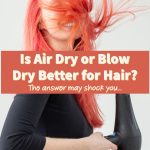Is It Better to Blow Dry or Air Dry Hair?
I've always assumed that it is better to air-dry hair than to blow-dry it. However, as I've embarked on the journey to fight hair loss, I've started to dig into the research rather than relying on conventional wisdom. I'm sure I'm not the only one who has wondered whether it's better to blow dry or air dry hair! Here we go with some answers.
There have actually been studies on heat blow drying hair versus air drying. This study out of the University of Korea found that the hair being in contact with water for longer damaged the hair's cell membrane. The inner hair from the heat-dried group was undamaged.
Their conclusion? “Although using a hair dryer causes more surface damage than natural drying, using a hair dryer at a distance of 15 cm with continuous motion causes less damage than drying hair naturally.” So using the right heat drying technique is actually better for the health of your hair.
If you're constantly torn between using a hairdryer or allowing it to dry naturally, this article seeks to settle the debate! While some swear by the convenience and speed of blow drying, others claim that air drying is the healthier option. Whether you're concerned about maintaining hair health, preventing damage, or achieving a specific style, we've got you covered.
Does Water Weaken Hair?
When the hair is swollen with water, it expands the cell membrane complex, making it weak. Since the hair stays wet for an extended time, air drying can cause damage to the inner layer of the hair. This means the less time your hair is wet, the better. The longer your hair stays wet, the more pressure that is put on the proteins that hold hair together. Hair can absorb up to 30 percent of it's own weight in water. The cortex of the hair is the middle layer of the shaft which provides strength. The longer hair stays wet, the more the cortex can swell and crack.
However, stay away from high heat for sure. High heat causes damage to the surface layer and can be cumulative over time. There is a correct way to heat dry your hair though which I'll address in more detail below.
Disclaimer: Links may contain affiliate links, which means we may get paid a commission at no additional cost to you if you purchase through this page. Read our full disclosure here.
This topic is of particular interest right now since I'm currently dealing with hair trauma. After reading several more articles with input and quotes from experts, I believe proper heat drying is the least damaging to hair. Plus since my hair is blonde, it's even more porous than other colors. The more porous your hair is, the more likely it is to be damaged when wet.

Given this information and other things I've read over the last month, here are my best tips for keeping your hair healthy and undamaged after washing.
Next up in my hair health series is how to prevent damage, stay tuned and click here to get notified when we have new hair health articles. I'll also be giving hair health updates and tips on the podcast.
Blow Drying Keeps Hair Cleaner for Longer
If you needed another reason why blow-drying hair is better than air drying, it actually keeps your hair looking cleaner for longer. According to this 1981 study, hair that is air-dried loses sebum at a slower rate. While on the surface this could seem like a good thing since your hair would retain moisture longer, it also means that it will look greasy more quickly.
Greasy-looking hair will cause you to wash your hair more frequently. What we really want for healthy hair is a balance of keeping the scalp and hair clean with just the right amount of sebum. The more frequently you have to wash the more likely your scalp is to get dried our and the more times your hair has to get wet. Since we've already established wet hair is the most fragile, striking the right balance between the least amount of washes while maintaining scalp balance and health is key.
As someone who was previously on board with air drying, I can definitely attest to air drying making my hair look greasier day two and three versus air drying. Since it will look worse more quickly, you'll end up washing your hair more frequently which can create more damage.
Best Tips for Healthy Hair Drying
- Squeeze excess water from your hair before leaving the shower.
- Never scrub your hair with a towel. Instead, gently squeeze your hair with an ultra-wicking towel, such as Aquis, then wrap loosely for a couple of minutes to remove excess moisture. Don't twist or put extra stress on the hair by making a turban. I've owned one of these microfiber towels for years and it's especially useful for long hair as it reduces drying time significantly.
- If your hair is damaged or fragile like mine is right now, use a hair repair mask. If you regularly color and/or highlight your hair, definitely use a hair repair mask! This is maybe the number one thing I would do differently with my hair if I could go back in time. While my old stylist would always use Olaplex when highlighting my hair, I should have been consistently using a repair mask a couple of weeks before and after each highlight.
- I chose K18 hair repair mask after learning more about its science. It works on more of the hair bonds than the other popular mask Olaplax. Using K18 consistently now for two weeks, I've definitely seen a change for the better. My hair feels less dry and brittle and is much more manageable. It's also a lot easier to use than other masks since you put it in after washing your hair and leave it. This is so much easier than trying to figure out whether you should stay in the shower for 10 minutes while your hair mask is working.
- I don't brush my hair while it's wet, even to distribute the product. This is the case for anyone with straight hair, it's more fragile when wet. Now that it's slightly stronger, I may start using my wet brush again or a detangling comb very gently. When your hair is brittle and damaged, generally avoid brushing when it's wet. The opposite is true for curly hair though. Brushing curly hair when wet is totally find and less damaging than when dry.
Best Tips for Healthy Hair Drying: Part 2
- Always use a leave-in detangler/heat protectant. This is another thing I would do differently if I could go back in time! Not only does it protect your hair while drying, it also protects it from UV damage. You know I'm all about clean beauty, so it took me a bit to find a detangler and protectant that wasn't full of toxins and harmful chemicals since Beautycounter doesn't have one. I'm currently using Bumble and Bumble Invisible Oil and Ceremonia.
- Now to the drying. While most hair dryers have a low heat setting, most of us don't use it. I'm telling you now USE IT. It will take your hair longer to dry but less heat equals less damage. I even went a step further and invested in an SRI DryQ infrared dryer, which has multiple benefits. More on that in a future post.
- In addition to low heat, keep your dryer moving as you dry the hair. Also, make sure to keep the dryer about six inches away from your hair. It will take a little longer to dry, but following these two rules protects the hair from heat damage.
- Once your hair is mostly dry, you can begin brushing it very gently. Start from the ends and work your way up while holding your hair just above where you're brushing. I can't stress enough that you should always be brushing your hair very gently, especially when it's damaged. Use a boar brush with nylon to help evenly distribute your scalp's natural oils and any you add.


